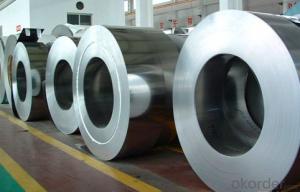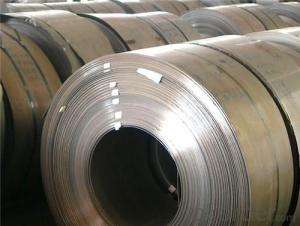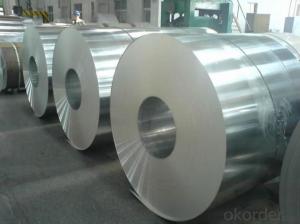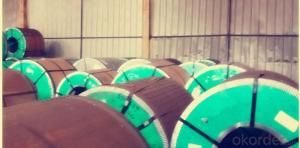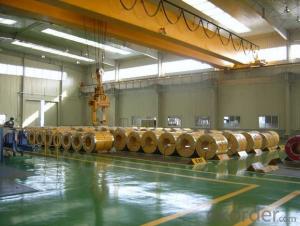Hot Rolled No.1 Finish Inox 304 Stainless Steel Coil
- Loading Port:
- Tianjin
- Payment Terms:
- TT OR LC
- Min Order Qty:
- 20 m.t.
- Supply Capability:
- 3000 m.t./month
OKorder Service Pledge
OKorder Financial Service
You Might Also Like
Hot Rolled No.1 Finish Inox 304 Stainless Steel Coil / Sheet
Specification:
Thickness: 0.1mm-20mm;
Width: 400mm-3000mm;
Length: 1m-6m;
Standard:JIS,AISI,ASTM,GB,DIN,EN
Products information:
Thickness | 0.1mm-20mm |
Width | 400-3000mm or customized |
Length | 1m-6m or customized |
Standard | ASME, ASTM, EN, BS, GB, DIN, JIS, etc |
Material Grade | 300series |
Surface | 2B, BA, 8K, No. 4, HL, etc. |
Brand name | TISCO, LISCO , ZPSS, BAOSTELL , etc. |
Packaging | Standard export sea-worthy packing |
Technique | Hot rolled stainless steel sheet and coil or Cold rolled stainless steel sheet and coil |
Delivery time | 7-15 working days |
Supply ability | 3000 tons/ month |
Remarks | Thickness, width, length, standard and tolerance can be customized. |

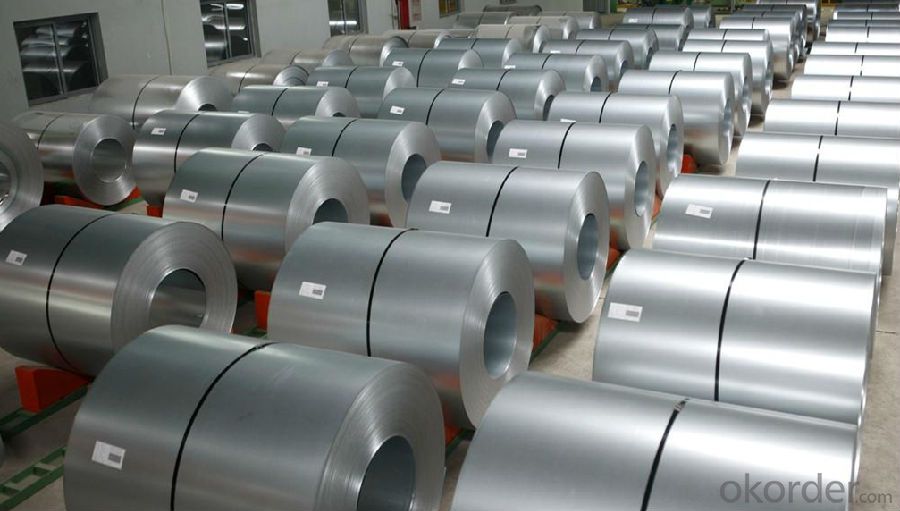

- Q: Can stainless steel strips be used in HVAC applications?
- Certainly, HVAC applications can indeed utilize stainless steel strips. Stainless steel, known for its high durability and resistance to corrosion, proves to be an ideal material for HVAC systems that are exposed to moisture, chemicals, and fluctuating temperatures. In fact, fabricating HVAC components like ducts, pipes, fittings, and heat exchangers frequently involves the use of stainless steel strips. These strips offer exceptional strength, longevity, and resistance to rust and corrosion, ensuring the HVAC system's reliability and efficiency in the long run. Furthermore, stainless steel's sanitary properties make it suitable for cleanroom environments or for handling delicate materials. All in all, stainless steel strips prove to be a versatile and dependable choice for various HVAC applications.
- Q: How do you measure the thickness of stainless steel strips?
- To measure the thickness of stainless steel strips, you can use various methods depending on the accuracy and precision required. Here are a few commonly used techniques: 1. Calipers: This is a simple and widely accessible tool for measuring thickness. Use a digital or vernier caliper with fine jaws to measure the distance between the two opposing surfaces of the strip. Ensure the caliper is perpendicular to the strip for accurate readings. 2. Micrometer: A micrometer is a more precise instrument for measuring thickness. It consists of a calibrated screw mechanism and anvil. Place the strip between the anvil and the spindle, and tighten the screw until it is snug. Read the measurement on the micrometer barrel for the thickness. 3. Ultrasonic Thickness Gauge: This non-destructive testing method utilizes sound waves to measure the thickness of materials. The gauge sends high-frequency sound pulses through the strip, and the time taken for the echo to return is used to calculate the thickness. Ultrasonic thickness gauges are suitable for measuring thicknesses of thicker strips. 4. Optical Profilometer: This advanced technique uses a laser or light source to analyze the height variations on the surface of the strip. By scanning the strip with the optical profiler, it can accurately measure the thickness by calculating the height differences. It is important to note that the choice of method depends on the thickness range, accuracy requirements, and availability of equipment. If precision is crucial, it is advisable to use a combination of methods or consult a professional for accurate measurements.
- Q: Can stainless steel strips be used in the mining industry?
- Yes, stainless steel strips can be used in the mining industry. Stainless steel is a versatile and durable material that offers excellent resistance to corrosion, high temperatures, and mechanical stress. These properties make it suitable for various applications in the mining industry. Stainless steel strips can be used in mining equipment and machinery, such as conveyors, crushers, screens, and tanks. They are commonly used for lining chutes and hoppers, as well as for fabricating wear-resistant parts and components. Stainless steel strips can also be used in the construction of mining infrastructure, such as pipelines, storage tanks, and processing plants. The mining industry often operates in harsh environments, including exposure to corrosive chemicals, abrasive materials, and extreme temperatures. Stainless steel's resistance to corrosion and high-temperature performance make it an ideal choice for applications where other materials may deteriorate quickly. Furthermore, stainless steel is easy to clean and maintain, which is crucial in the mining industry where cleanliness is essential for optimizing operational efficiency, reducing downtime, and ensuring product quality. In summary, stainless steel strips can be effectively used in the mining industry due to their corrosion resistance, high-temperature performance, durability, and ease of maintenance. They provide a reliable and long-lasting solution for various applications in mining equipment, machinery, and infrastructure.
- Q: What are the benefits of using 111 stainless steel strips over other materials?
- Using 111 stainless steel strips instead of other materials provides numerous advantages. To begin with, 111 stainless steel exhibits exceptional resistance to corrosion and oxidation, making it suitable for utilization in different environments, including those with high humidity or exposure to chemicals. This resistance guarantees that the stainless steel strips have a longer lifespan compared to alternative materials, thereby reducing the frequency of replacements and resulting in long-term cost savings. Furthermore, 111 stainless steel strips possess remarkable strength and durability. They can bear heavy loads and are highly resistant to wear and tear. These properties make them ideal for applications necessitating high strength and reliability, such as the construction, automotive, and industrial sectors. Moreover, 111 stainless steel strips offer superior heat resistance. They can withstand elevated temperatures without compromising their structural integrity, rendering them appropriate for utilization in extreme temperature conditions, such as in furnaces or industrial ovens. Additionally, stainless steel is a hygienic material that is easy to clean and maintain. It lacks pores, preventing the growth of bacteria, and is thus suitable for applications in the food and medical industries. Moreover, it is resistant to staining, ensuring a clean and visually appealing appearance. Lastly, 111 stainless steel strips are versatile and can be easily fabricated into various shapes and sizes, allowing for customization to meet specific project requirements. This adaptability makes them suitable for a wide array of applications, ranging from architectural and decorative purposes to structural components. In conclusion, the benefits of utilizing 111 stainless steel strips encompass corrosion resistance, strength and durability, heat resistance, hygiene, and versatility. These properties establish them as a preferred choice in numerous industries, guaranteeing longevity, reliability, and cost-effectiveness.
- Q: What is the coefficient of thermal expansion of stainless steel strips?
- The coefficient of thermal expansion for stainless steel strips varies depending on the grade and composition of the alloy. When compared to other metals, stainless steel generally has a lower coefficient of thermal expansion. The coefficient of thermal expansion for most stainless steel alloys falls within the range of 10.8 to 16.5 × 10^-6 per °C (6.0 to 9.2 × 10^-6 per °F). This means that the stainless steel strip will expand by the specified coefficient for every degree Celsius increase in temperature. However, it is important to note that different stainless steel grades may have slightly different coefficients due to variations in their alloy composition. Therefore, it is crucial to refer to specific technical data to obtain the precise coefficient of thermal expansion for a particular grade of stainless steel.
- Q: Can stainless steel strips be used for knife blades?
- Yes, stainless steel strips can be used for knife blades. Stainless steel is a common material choice for knife blades due to its corrosion resistance and durability. It provides good strength and cutting performance, making it suitable for various cutting tasks.
- Q: Are stainless steel strips suitable for architectural sculptures?
- Yes, stainless steel strips are suitable for architectural sculptures. Stainless steel is a highly versatile material that offers several advantages for creating architectural sculptures. Firstly, stainless steel is known for its durability and resistance to corrosion, making it ideal for outdoor sculptures that are exposed to various weather conditions. This ensures that the sculptures will maintain their aesthetic appeal and structural integrity over time. Additionally, stainless steel has a sleek and modern appearance, which can enhance the visual appeal of architectural sculptures. Its reflective surface can create interesting light and shadow effects, adding depth and dimension to the artwork. Stainless steel can also be easily manipulated and shaped into various forms, allowing artists to create intricate and complex designs. Moreover, stainless steel is a sustainable and eco-friendly material choice. It is 100% recyclable, meaning that it can be reused and repurposed, reducing waste and contributing to a greener environment. Overall, stainless steel strips are well-suited for architectural sculptures due to their durability, aesthetic appeal, versatility, and eco-friendliness.
- Q: Can stainless steel strips be used in the pulp and paper industry?
- Indeed, the utilization of stainless steel strips is possible within the pulp and paper industry. Stainless steel, a versatile and corrosion-resistant material, is highly appropriate for various industrial applications, including the pulp and paper sector. In the realm of pulp and paper manufacturing processes, stainless steel strips find application in the creation of diverse components and equipment. These strips can be employed to fabricate screens, filtration systems, rotary vacuum filters, and other equipment that necessitate robustness and resistance to corrosive substances like chemicals, acids, and moisture. The exceptional corrosion resistance properties of stainless steel render it an optimal selection for the pulp and paper industry. This industry, characterized by the presence of harsh chemicals and high humidity, can lead to swift deterioration of equipment composed of alternative materials. By utilizing stainless steel strips, manufacturers can ensure the longevity of equipment, minimize maintenance expenses, and enhance production efficiency. Moreover, stainless steel is renowned for its hygienic properties, rendering it suitable for applications in the production of food-grade paper products. Additionally, it is effortless to clean and maintain, a trait of utmost importance in industries where cleanliness and hygiene are of paramount significance. To summarize, the use of stainless steel strips in the pulp and paper industry is indeed feasible due to their corrosion resistance, strength, and hygienic properties. Their employment can enhance the performance, durability, and efficiency of equipment, thereby contributing to a more sustainable and productive manufacturing process.
- Q: Can stainless steel strips be used in pharmaceutical applications?
- Indeed, pharmaceutical applications can make use of stainless steel strips. Thanks to its remarkable mechanical properties and high corrosion resistance, stainless steel proves to be a fitting material for diverse pharmaceutical processes. It is frequently employed in the production of pharmaceutical equipment, including storage tanks, mixing vessels, and piping systems. When it comes to fabricating components that demand strength, durability, and resistance to chemicals and cleaning agents, stainless steel strips often come into play. Moreover, stainless steel remains non-reactive and does not release any harmful substances, effectively preserving the integrity and purity of pharmaceutical products.
- Q: Are stainless steel strips suitable for appliance handles?
- Yes, stainless steel strips are highly suitable for appliance handles. Stainless steel is known for its durability, corrosion resistance, and sleek appearance, making it an ideal material for handles that are regularly used and exposed to moisture. Moreover, stainless steel can easily be cleaned and maintained, ensuring the longevity and cleanliness of the appliance handles.
Send your message to us
Hot Rolled No.1 Finish Inox 304 Stainless Steel Coil
- Loading Port:
- Tianjin
- Payment Terms:
- TT OR LC
- Min Order Qty:
- 20 m.t.
- Supply Capability:
- 3000 m.t./month
OKorder Service Pledge
OKorder Financial Service
Similar products
Hot products
Hot Searches
Related keywords


